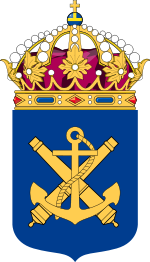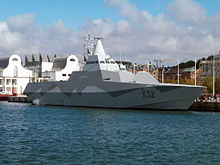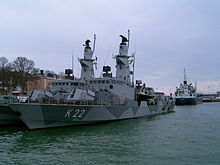- Swedish Navy
-
The Swedish Navy 
Coat of arms of the Royal Swedish Navy.Founded June 7, 1522 Country Sweden Part of Swedish Armed Forces Commanders Current
commanderRear Admiral Anders Grenstad Insignia The Swedish Naval Ensign 
The Royal Swedish Navy (Swedish: Marinen) is the naval branch of the Swedish Armed Forces.[1] It is composed of surface and submarine naval units – the Fleet (Flottan) – as well as marine units, the so-called Amphibious Corps (Amfibiekåren).
In Swedish, vessels of the Swedish Navy are given the prefix "HMS," short for Hans/Hennes Majestäts Skepp (His/Her Majesty's Ship). In correct English "HSwMS" (for "His Swedish Majesty's Ship") is used for Royal Swedish Navy ships when it is necessary to differentiate them from vessels from Her Britannic Majesty's Royal Navy.[citation needed]
Contents
History
The old Swedish kings (ca. 9th-14th centuries) organised a Swedish Royal Navy along the coastline via an organisation referred to as "ledungen". These would be combined rowing and sailing ships (without artillery). This organisation became obsolete with the development of society and warfare. Probably no later than in the 14th century, the duty to serve in "ledungen" was replaced by tax. In 1427, when Sweden was still part of the Kalmar Union (with Denmark and Norway), Swedish warships did however participate in the naval battle of Öresund (the Sound) against the Hanseatic League. It is unclear how this force was organised and exactly on what basis.
On June 7, 1522, one year after the separation of Sweden from the Kalmar Union, Gustav Vasa purchased a number of ships from the hanseatic town of Lübeck which is often recorded in official Swedish history since the 19th century as the birth of the current Swedish Navy. (The museum ship Vasa in Stockholm was e.g. a 17th-century ship of the Royal Swedish Navy (Kungliga flottan)).
The Amphibious Corps dates back to January 1, 1902, when a separate "Coastal Artillery" (Kustartilleriet) was established, and Marinen came into use as the name of the service as a whole. The last decade of the 20th century saw the abandonment of the coastal fortifications and the force became a more regular marine corps, renamed Amfibiekåren (the Swedish Amphibious Corps) in 2000.
Organization
Until recently, the Navy was led by the Chief of the Navy (Chefen för Marinen, CM), who was typically a Vice Admiral. This office has been eliminated, and the highest officer of the Navy is now the Naval Inspector (Marininspektören), Rear Admiral Anders Grenstad.
The Marine units uses the same system of rank as the Army.
- 1st Submarine Flotilla (1. ubflj) located at Karlskrona
- 3rd Naval Warfare Flotilla (3. sjöstridsflj) located at Karlskrona
- 4th Naval Warfare Flotilla (4. sjöstridsflj) located at Berga.
Amphibious units
- 1st Marine Regiment (Amf 1) located in Berga
Bases
- Karlskrona naval base (MarinB) located at Karlskrona with detachments at Muskö, Berga, Göteborg, Visby, Malmö and Härnösand.
Equipment
 The Swedish destroyer HMS Östergötland, decommissioned 1982
The Swedish destroyer HMS Östergötland, decommissioned 1982
In the decades following World War II, the Swedish Navy was organised around three light cruiser groups (Tre Kronor, Göta Lejon and Gotland). In the early 1960s a decision was implemented to scrap the cruisers and move towards a lighter fleet. The last cruiser, Göta Lejon, was sold in 1970 to Chile, where she was renamed Almirante Latorre. The fleet at the time comprised some 24 destroyers and frigates for surface warfare (mainly in the Baltic Sea) and anti-submarine warfare.
The Swedish Navy started to experiment with missiles, based on a recovered German V-2 missile, as early as 1944. The main armament of the fleet was artillery and torpedoes for surface warfare and anti-submarine rockets for anti-submarine warfare. Helicopters (Alouette, Boeing Vertol) were introduced in the late 1950s and 1960s and this fleet air arm remained an integral part of the fleet and its operations until an independent helicopter arm was created in 1990s.
In 1972 the government decided to scrap all military protection of merchant shipping to allow the de-commissioning of all destroyers and frigates. This limited the endurance of the navy considerably, but the use of smaller short-range ships was at the time deemed adequate by the government for anti-shipping missions along the coast and in the archipelago. In the 1980s this assessment was proven wrong by repeated failures by the Swedish Navy in anti-submarine warfare operations with inadequate ships and equipment. Today the largest (surface) combat ships are corvettes which combine surface warfare, anti-submarine warfare and mine clearance functions with a better endurance and seaworthiness than the budget fleet from the 1980s.
Since the 1980s Swedish surface warships have been named after Swedish cities, while submarines are named after Swedish provinces and minehunters after Swedish lighthouses. The surface ships are mostly small, relying on agility and flexibility. Examples of these are the Stockholm and Göteborg class corvettes. The Navy is currently taking into service the new, larger, Visby class of stealth corvettes. A new submarine class, Gotland, similar to the older Västergötland, has recently been commissioned. Its air-independent Stirling engine enables submerged endurance never before seen in conventional submarines. The Gotland has been on lease with crew and all to the US Navy and was based in San Diego.
The Marine Battalion is built around the Stridsbåt 90H, a small combat boat capable of carrying 21 troops for fast transports and landings in the archipelago. It is also equipped with larger transport boats, but relies on the army, navy and air force for heavy transports and protection.
Surface vessels
Corvettes
Class Number
of shipsBuilder Origin Notes Stockholm class 2 Karlskronavarvet AB  Sweden
SwedenGöteborg class 4 Karlskronavarvet AB  Sweden
SwedenVisby class 5 Karlskronavarvet AB  Sweden
Sweden2 commissioned Minesweeper
Class Number
of shipsBuilder Origin Landsort class 5 Karlskronavarvet AB  Sweden
SwedenSweden Styrsö class 4 Karlskronavarvet AB  Sweden
SwedenPatrol Boat
Class Number
of shipsBuilder Origin Tapper class 12 Djupviks varv  Sweden
SwedenSweden Combat Boat
- Stridsbåt 90 (187 in service)
- Stridsbåt 90E (5 in service)
Submarines
- Gotland class (3 in service)
- Södermanland class (2 in service)
Auxiliary vessels
- Landing craft
- ~100 G class
- Auxiliary vessels
- HMS Carlskrona (M04) (Minelayer, planned to take part of the EUNAVFOR operation in Africa)
- HMS Visborg (A265) (Älvsborg-class support vessel, decommissioned)
- HMS Trossö (A264) (modified Russian Akademik Shuleykin class) patrol craft tender
- SIGINT vessels
School ships
- Schooners
- edit] Strategy
For many years the Swedish Navy was built around mainly two tasks, to stop a full-scale invasion over the Baltic Sea and protection of Swedish merchant shipping (Sweden's geographical location on the Scandinavian peninsula effectively makes it an island. 90% of all import and export to Sweden is performed by merchant shipping). In 1972, the government at the time however decreed that other measures than military should protect merchant shipping (no details were ever disclosed what those "other measures than military" would actually consist of).
Today the navy is changing rapidly. With the collapse of the Soviet Union it is argued that the only viable threat in the local area disappeared[citation needed]. However, with the re-armament of Russia, its unstable democratic development, and the potentially increased strategic importance of the Baltic Sea, there are voices[who?] that Sweden needs to patrol the Baltic Sea. From 1995, Sweden and Swedish mine-clearance units furthermore took the lead[citation needed] in clearing the waters of Estonia, Latvia and Lithuania from thousands of mines and other explosives.
The army and air force have a presence in UN missions. The Swedish Navy has four rapidly deployable units on 30 days standby. These are a corvette squadron (two Göteborg class) with a support ship, a minecountermeasures squadron (two Landsort class) with a support ship, one submarine, and a forward naval support element. In the near future there will also be an amphibious unit on 30 days standby.
The Swedish naval UN operation started in October 2006 when the corvette HMS Gävle joined the United Nations Mission in Lebanon, UNIFIL for surveillance missions along the coast of Lebanon. HMS Gävle was relieved by HMS Sundsvall, which returned to Sweden in September 2007.
HMS Malmö, HMS Stockholm and HMS Trossö took part in the EUNAVFOR operation outside Africa
Currently HMS Carlskrona is representing the Royal Swedish Navy in the EUNAVFOR which was the flagship the EUNAVFOR housing the FHQ led by Commodore (Flottiljamiral) Jan Thörnqvist[2]
See also
- Royal Swedish Society of Naval Sciences
- Leidang
- List of Swedish wars
- List of Swedish military commanders
- List of Swedish monarchs
- List of ships of the Swedish Navy
- List of Swedish steam battleships
- Swedish Admirals
References
External links
Swedish Armed Forces 
Current navies in Europe Sovereign
states- Albania
- Andorra
- Armenia
- Austria
- Azerbaijan
- Belarus
- Belgium
- Bosnia and Herzegovina
- Bulgaria
- Croatia
- Cyprus
- Czech Republic
- Denmark
- Estonia
- Finland
- France
- Georgia
- Germany
- Greece
- Hungary
- Iceland
- Ireland
- Italy
- Kazakhstan
- Latvia
- Liechtenstein
- Lithuania
- Luxembourg
- Macedonia
- Malta
- Moldova
- Monaco
- Montenegro
- Netherlands
- Norway
- Poland
- Portugal
- Romania
- Russia
- San Marino
- Serbia
- Slovakia
- Slovenia
- Spain
- Sweden
- Switzerland
- Turkey
- Ukraine
- United Kingdom
- Vatican City
States with limited
recognition- Abkhazia
- Kosovo
- Nagorno-Karabakh Republic
- Northern Cyprus
- South Ossetia
- Transnistria
- edit] Strategy
Categories:- Military of Sweden
- Royal Swedish Navy
Wikimedia Foundation. 2010.
Look at other dictionaries:
Royal Swedish Navy Cadet Band — The Royal Swedish Navy Cadet Band at Changing of the Guards parade, Stockholm 2009 The Royal Swedish Navy Cadet Band is a military band that was created in 2002 in cooperation with the Swedish Armed Forces Music Centre and the Royal Swedish Navy… … Wikipedia
The Royal Swedish Navy Youth Band — The Royal Swedish Navy Youth Band, RSwNYB The Royal Swedish Navy Youth Band, RSwNYB is a project that was created in 2002 in cooperation with The Swedish Armed Forces Musiccentre and the Royal Swedish Navy Band.Now the RSwNYB has been active for… … Wikipedia
List of ships of the Swedish Navy — This is a list of ships of the Swedish Navy.Aircraft cruisers*HMS Gotland Corvettes*HMS Gävle (K22) *HMS Göteborg (K21) *HMS Helsingborg (K32) *HMS Härnösand (K33) *HMS Kalmar (K23) *HMS Karlstad (K35) *HMS Malmö (K12) *HMS Nyköping (K34) *HMS… … Wikipedia
Swedish Armed Forces — Försvarsmakten Coat of Arms of the Swedish Armed Forces Service branches … Wikipedia
Swedish-Norwegian War (1814) — Swedish Norwegian War Part of Napoleonic Wars The Constituent Assembly at Eidsvoll in 1814 … Wikipedia
Swedish inventions — are novel ideas and machines that have been pioneered in Sweden. In the 18th century Sweden s scientific revolution took off. Previously, technical progress had mainly come from professionals who had immigrated from mainland Europe. In 1739, the… … Wikipedia
Swedish allotment system — Drawing of Swedish soldiers belonging to the new allotment system and wearing uniforms of the 1830s The allotment system (Swedish: indelningsverket; Finnish: ruotujakolaitos) was a system used in Sweden for keeping a trained army at all times.… … Wikipedia
Swedish submarine incidents — The submarine hunts or submarine incidents were a series of several incidents involving foreign submarines that occurred in Swedish territorial waters during the Cold War, more specifically during the 1980s. In this time, there was intensive… … Wikipedia
Swedish coastal artillery — The Swedish coastal artillery has its origin in the Archipelago Artillery that was raised in 1866. The Coastal Artillery was formed from the Archipelago Artillery, the Marine Regiment and parts of the Artillery in 1902. Kustartilleriet,… … Wikipedia
Swedish National Defence Radio Establishment — Infobox Government agency agency name = Swedish National Defence Radio Establishment nativename = Försvarets radioanstalt seal width = 160px seal caption = Unofficial rendering of the coat of arms of the Swedish National Defence Radio… … Wikipedia


